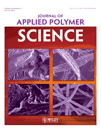Epoxidized perfluoropolyethers: A route to hydrophobic, negative-tone photoresists
Abstract
The synthesis, formulation, and wafer level processing conditions of a heavily fluorinated hydrophobic photoresist was demonstrated. The synthesis is based on terminal epoxy modification of commercially available perfluoropolyethers. Structural characterization shows that terminal epoxide can open during the synthetic process, but in a simple formulation has a negligible effect on photoresolution of the photoresist. Formulation into a traditional photoresist requires careful selection of appropriate cosolvents to ensure solubility of the hydrophobic epoxy and hydrophilic photoacid generator while attaining adequate coating quality. Formulation processing conditions are presented and the chemical resistance of the resist through aggressive processing steps is demonstrated. Wafer level patterning using traditional photolithographic tools illustrates the applicability of the formulation and process conditions for traditional resist or microfluidic applications. © 2011 Wiley Periodicals, Inc. J Appl Polym Sci, 2011




